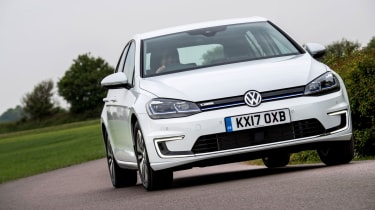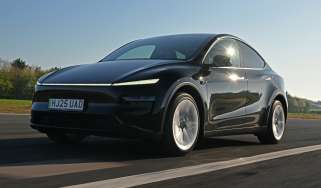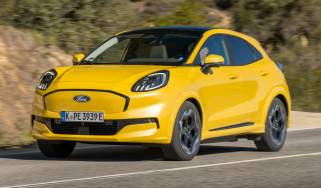Volkswagen e-Golf (2014-2019) review
The Volkswagen e-Golf offers all the practicality of Volkswagen's five-door hatchback and is almost as good to drive, too
Pros
- Great to drive
- Super-low company-car tax
- Looks like a mainstream Golf
Cons
- Relatively expensive to buy
- Shorter range than key rivals
- Smaller boot than a regular Golf
| Car type | Official range | Wallbox charge time | Fast charge time |
|---|---|---|---|
| Electric | 144 miles | 5hrs 15mins (7.4kW, 0-100%) | 36mins (50kW, 10-80%) |
The Volkswagen e-Golf was a very important car when it launched in 2014, as it was the German car giant’s first all-electric family hatchback and remained on sale for five years. It’s practical, fun to drive and appeals to buyers after the benefits of an electric car combined with the low-key conservative styling of the regular Golf.
Unlike the Volkswagen ID.3, which was designed from the ground up as a fully electric model, the e-Golf is closely linked to other Mk7 Golfs, albeit with a fully-electric motor under the bonnet and battery pack beneath the boot. It offers a relatively short range of up to 144 miles (more like 130 in real-world driving conditions), which is comparable to rivals such as the MINI Electric and Honda e. But, the Nissan Leaf is capable of a 168-mile range, while long-range versions of the Hyundai Kona Electric and Kia Niro EV can travel much further still.
The Volkswagen e-Golf is fitted with a 134bhp electric motor which drives the front wheels via a single-speed transmission. It’s powered by a 35.8kWh battery, which is considerably smaller than some other EVs, given that it was squeezed into a car originally designed to accommodate a conventional petrol or diesel engine. For some, though, the e-Golf’s similarity to the conventional Golf is part of the appeal, but there are some subtle distinguishing features such as a blanked-off grille, aerodynamic alloy wheels and blue-accented trim.
Charging can be taken care of using a domestic supply, with a full charge from empty taking just over five hours using a wallbox at home. However, most owners will only be topping up a partially used battery overnight, so returning to maximum charge will be much quicker than that. Use one of the ever-growing network of public chargers and you can get back to 80% capacity in just over 30 minutes.
The e-Golf carries around a heavy battery, and that means noticeable extra weight to lug around. This blunts the agility and poise of the standard Golf chassis a fraction, but not enough to take all the fun out of driving it – in fact, the e-Golf remains one of the best pure-electric cars to drive given its direct handling and relaxed ride comfort. The e-Golf also feels quite happy and unstrained at normal motorway speeds.
There’s only one trim level but the equipment levels helped to justify the e-Golf’s price. Standard kit included a Discover Pro navigation system with gesture control and a 9.3-inch infotainment touchscreen. Adaptive cruise control, LED headlamps and Car-Net App-Connect smartphone connectivity are also included.
From the driving seat or any of the passenger seats, the e-Golf experience is remarkably similar to any other model in the line-up. You get the same dashboard layout and interior trim, identical interior space and the freedom to choose many of the same optional extras. Boot space is reduced a little by the underfloor batteries, but still offers a reasonable amount of room.
With typical Volkswagen build quality and a comprehensive safety package built in, the e-Golf is one of the most reassuring and easily accessible ways to get into electric motoring – for those who can afford the purchase price, anyway. It makes a lot of sense for families with a daily school run and for city-based business users, although by its very nature, the electric Golf does have a more conservative feel than its BMW i3 rival. For a more detailed look at the Volkswagen e-Golf, read on for the rest of our in-depth review...



